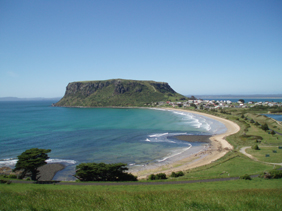STANLEY, with a population of around 460 people, is a totally restored Bass Strait fishing village with tiny, brightly-painted cottages neatly terraced on the lower slopes of an extinct volcano known as The Nut. Stanley's fairytale village nestles impressively close to The Nut on an isthmus that creates a half-kilometre arc of clean and sandy ocean beach on one side and a huge sheltered bay to landward that in turn contains the small fishing harbour. Take the chairlift, or hike, to the top of The Nut and you will be rewarded with sensational views.
Despite the relatively stagnant population, real estate is booming with many new private homes being built and homes being converted to bed & breakfast accommodation, house prices in Stanley are more than competitive in the regional market.
SMITHTON is the commercial hub of this part of the North West and an ideal place stock up on food, drinks, petrol and cash for your travels further afield. MARRAWAH and ARTHUR RIVER are small communities overlooking the Southern Ocean and favourite destinations for surfing and fishing enthusiasts. Both are great places to rest before the most interesting and remote section of any North West tour - the Western Explorer Highway south to Corinna, Zeehan and Strahan.
Accommodation
Despite the relatively stagnant population, real estate is booming with many new private homes being built and homes being converted to bed & breakfast accommodation, house prices in Stanley are more than competitive in the regional market.
SMITHTON is the commercial hub of this part of the North West and an ideal place stock up on food, drinks, petrol and cash for your travels further afield. MARRAWAH and ARTHUR RIVER are small communities overlooking the Southern Ocean and favourite destinations for surfing and fishing enthusiasts. Both are great places to rest before the most interesting and remote section of any North West tour - the Western Explorer Highway south to Corinna, Zeehan and Strahan.
Stanley
B&B’s, caravan and cabin parks, hotels and motels, and self-contained apartments, units and historic cottages. Advance bookings are strongly recommended all year. If you have not pre-booked accommodation and plan to stay overnight in Stanley between December and April you are advised to ring in advance and secure accommodation prior to driving to Stanley. Accommodation enquiries and bookings can be made through the Visitor Information Centre.
B&B’s, caravan and cabin parks, hotels and motels, and self-contained apartments, units and historic cottages. Advance bookings are strongly recommended all year. If you have not pre-booked accommodation and plan to stay overnight in Stanley between December and April you are advised to ring in advance and secure accommodation prior to driving to Stanley. Accommodation enquiries and bookings can be made through the Visitor Information Centre.
Motor Homes
Motor homes, caravans and camping available at Stanley Cabin and Tourist Park. Toilet, shower, laundry facilities and fully equipped camper’s kitchen and barbecues.
Motor homes, caravans and camping available at Stanley Cabin and Tourist Park. Toilet, shower, laundry facilities and fully equipped camper’s kitchen and barbecues.
Designated Sullage Point
Tatlows Beach Carpark. Wharf Road, Stanley
West Esplandade Carpark, Smithton.
Tatlows Beach Carpark. Wharf Road, Stanley
West Esplandade Carpark, Smithton.
Smithton
B&B’s, hotels and motels, and self-contained accommodation. Advance bookings strongly recommended all year. Accommodation enquiries and bookings can be made through the Stanley Visitor Information Centre.
B&B’s, hotels and motels, and self-contained accommodation. Advance bookings strongly recommended all year. Accommodation enquiries and bookings can be made through the Stanley Visitor Information Centre.
Arthur River and Marrawah
Caravan and cabin park, and self-contained accommodation. Advance bookings strongly recommended all year. If you have not pre-booked accommodation and plan to stay overnight in Arthur River or Marrawah between December and April you are advised to ring in advance and secure accommodation prior to driving to Arthur River or Marrawah. Accommodation enquiries and bookings can be made through the Stanley Visitor Information Centre.
Caravan and cabin park, and self-contained accommodation. Advance bookings strongly recommended all year. If you have not pre-booked accommodation and plan to stay overnight in Arthur River or Marrawah between December and April you are advised to ring in advance and secure accommodation prior to driving to Arthur River or Marrawah. Accommodation enquiries and bookings can be made through the Stanley Visitor Information Centre.
Internet Cafes
Stanley Information Visitor Centre, 45 Main Road, Stanley. Tel: (03) 6458 1330.
Stanley Cabin and Tourist Park, 1 Wharf Road, Stanley. Tel: (03) 6458 1266.
Stanley Cabin and Tourist Park, 1 Wharf Road, Stanley. Tel: (03) 6458 1266.
Banks & ATMs
Stanley
ANZ Bank agency, Stanley Newsagent, Church Street †
Commonwealth Bank agency, Post Office, Church Street †
Bass & Equitable Agents, It's All Good Health Food Store, Emmett Street, Smithton †
Self Funded ATM, Stanley Roadhouse, Stanley Highway †
ANZ Bank agency, Stanley Newsagent, Church Street †
Commonwealth Bank agency, Post Office, Church Street †
Bass & Equitable Agents, It's All Good Health Food Store, Emmett Street, Smithton †
Self Funded ATM, Stanley Roadhouse, Stanley Highway †




